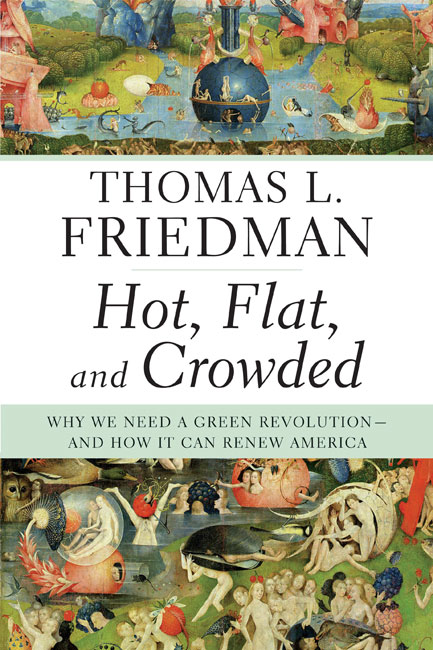
The novel Hot, Flat, and Crowded by Thomas Friedman is a very intriguing and thought provoking book that I thoroughly enjoyed reading. This book is an “eye-opener” as it tells how if we, in this generation, do not do anything to care for the environment and make the planet more green, the earth will be near unlivable due to population growth and temperature increase by as early as 2050, well within our lifetime.
This novel is fascinating as it tells about the nature of people and why we need to change in order to help the planet. Friedman explains that people are only interested in what will easily make them money or in what will directly affect them in the near future. However, in order to save the planet for future generations, people now have to make sacrifices. I completely agree with this analysis and think that the government and governments around the world, especially in fast growing countries like China, need to impose laws with environmental standards such as gas and coal taxes, as this book suggests.
I believe that this book makes many good points about the United States and I agree that we need to set an example for the world by “going green”. I concur that if we do this by reducing our reliance on oil, we will not only increase our efficiency and ingenuity, but will also become a more independent nation.
I enjoyed Friedman’s view of the future with the “Smart Black Box”, and I think that if everyone in the world cooperates we can achieve a similar situation in a matter of years. I agree with his proposition that this would require the education of people in many countries on the ways of energy efficiency, which would not only increase the standard of living around the world, but would help to improve environmental conditions by raising awareness. I think that these ideas are essential to the world and implementing them is going to be the only way of protecting the earth for years to come.
I believe that this book truly represents the world today as well as what we should strive for it to be in the future. This book has a very important message and should be read by everyone.

 of my hair and the object. When two objects are rubbed together, they can become charged as electrons move from one object to the other. In the situation with hair, electrons probably move out of the chair or hat, making it positively charged with excess protons, and into my hair giving it an excess of electrons and making it negatively charged. Since the two objects are then oppositely charged, they attract, sticking together as I try to pull them apart. Throughout this process, charged is conserved as electrons are transferred between objects and not lost.
of my hair and the object. When two objects are rubbed together, they can become charged as electrons move from one object to the other. In the situation with hair, electrons probably move out of the chair or hat, making it positively charged with excess protons, and into my hair giving it an excess of electrons and making it negatively charged. Since the two objects are then oppositely charged, they attract, sticking together as I try to pull them apart. Throughout this process, charged is conserved as electrons are transferred between objects and not lost.


